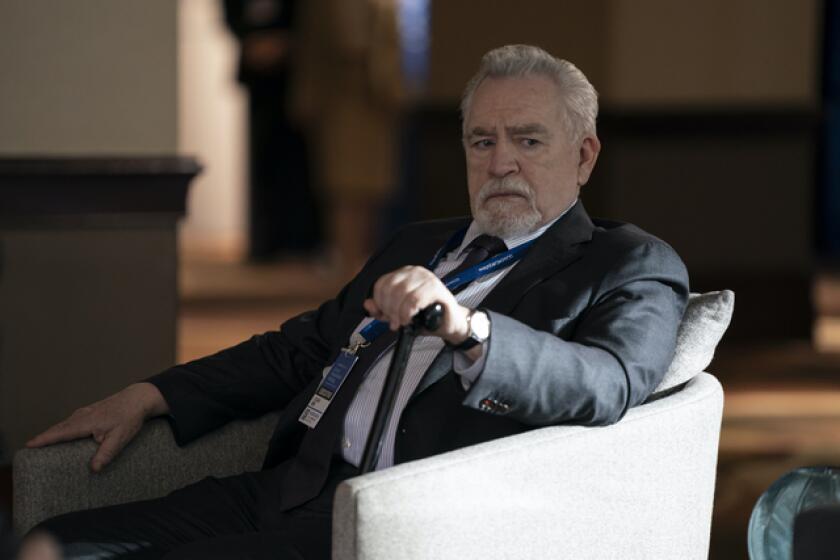Inside the ‘element of geometry’ that made this ‘Succession’ scene a work of art

- Share via
Over three gripping seasons, HBO’s “Succession” has followed ruthless members of the Roy family as they wheedle and extort their way to a place atop the media empire they feel entitled to. Sunday’s Season 3 finale packed an emotional wallop as patriarch Logan Roy — and Shiv’s husband, Tom Wambsgans — forged an unholy alliance to sell Waystar to the tech firm GoJo; the deal effectively cuts the Roy children out of controlling the family business.
Yet Sunday’s twist ending isn’t the moment that seemed to resonate most with fans. Instead, it was an intimate frame depicting three Roy siblings, Roman (Kieran Culkin), Kendall (Jeremy Strong) and Shiv (Sarah Snook), united in their misery as it dawns on them that their father really is selling their birthright. In the scene, they sheepishly attempt to comfort one another as their worlds unravel. This unusual intimacy is brought into sharp relief by the blistering midday sun hovering above them, the angles of a rectangular building that frames their figures, and the low, wide-angle perspective. The camera lingers for a discomfiting few seconds while the three of them silently fall apart together. It’s as though we’re huddled in the fetal position next to them.
Hudson Yards provides the ideal backdrop for “Succession’s” callow self-interest. Plus, bidding Sondheim adieu and “The Band’s Visit” lands in L.A.
The scene is a notable departure for “Succession,” a show frequently shot at eye level and in an observational style, often at a remove. “We have a very specific role that the camera plays, which is, for the most part, a combination of being as invisible as possible whilst at the same time helping sell the idea that the camera is barely keeping up with the events that are out of our control,” says director Mark Mylod, who helmed the Season 3 finale. “And we have to document them and capture them on the fly, with all the imperfections that go with that.”
Although the dynamics in this particular scene played out spontaneously among the three actors, the intention behind it involved using “the location so that [Shiv] could effectively walk upstage, remain in the shot, and come back and grow into the three-shot again,” Mylod explains. “There was an element of geometry to that.”
The complete guide to home viewing
Get Screen Gab for everything about the TV shows and streaming movies everyone’s talking about.
You may occasionally receive promotional content from the Los Angeles Times.
Given the series’ idiosyncratic shooting style — with characters partially blocking others, or quick-zoom shots employed in lieu of close-ups — this beautifully rendered composition is a startling contrast. Some fans have gone a step further, likening the still to a painting that wouldn’t be out of place in a museum, and not unlike art of the Renaissance or Baroque era à la Michaelangelo or Artemisia, respectively. One fan even traced the golden ratio, a mathematical principle critical to Renaissance artists such as Leonardo da Vinci, onto a screen grab of the wrenching moment among the Roys.
The internet’s proclivity for singling out a well-composed image and deeming it “Renaissance!” isn’t a new phenomenon. An astonishing 2014 photograph depicting an unruly Ukrainian parliament fracas drew Renaissance-esque parallels; writing about the phenomenon, Fast Company described the image as “in line with classic art — elevating the participants to the level of avenging angels, rather than nationalist leaders at odds over the Crimean crisis.”
There’s a subreddit dedicated to mining everyday moments that evoke an “Accidental Renaissance” image, and a “Tabloid Art History” Twitter account has drawn parallels between Keanu Reeves on the set of “John Wick: Chapter 3 — Parabellum” and a Francisco Goya painting. Enterprising, very online artists have rendered photographs-turned-memes into watercolor pieces, such as the one of a chaotic New Year’s Eve 2016 scene in Manchester, England. Like the “Succession” scene in question, countless images that the online masses have dubbed Renaissance in style have had the golden ratio superimposed upon them.
In Season 2, HBO’s Emmy-winning drama walked a tightrope of savage comedy and Shakespearean drama. In Season 3, it’s lost its balance.
Comparing a contemporary image to a Renaissance painting isn’t really about accuracy, says Amanda Brennan, an internet librarian and senior director of trends at the social media agency XX Artists. “It doesn’t matter to the average person when the painting was created,” she says. “People are just saying, ‘Yeah, this image evokes all of the feelings that a painting would.’” (It’s worth noting that in the past, “Succession” has subtly utilized art from the Renaissance and Baroque eras as a part of its set design, including Dutch artist Peter Lely’s painting “Portrait of Louise de Keroualle, Duchess of Portsmouth,” which is on view at the Getty.)
While shooting this scene in the finale, Mylod didn’t have a specific inspiration in mind; he says the composition of the three actors was driven by the emotion the moment in the story demanded. “I’m not an academic filmmaker. Any smarts that I might have is instinct and what you might call emotional intelligence,” he says. “When you’re in the moment or when you’re building with your colleagues, all of this becomes somewhat subliminal and intuitive. I hadn’t thought, ‘Oh, let’s make this a Rembrandt-style shot or something.’
Who lived? Who died? And where does that leave the Roys? We dig into every twist and turn of “Succession’s” extraordinary Season 3 finale.
“That scene, what it called for emotionally, for me, was stillness,” Mylod adds. “Which is a very powerful tool in ‘Succession,’ because we don’t do it very often. And when it does happen, it tends to have an impact when we do it correctly.”
This rare moment of stillness is undoubtedly what has captivated viewers. It may also offer a reason why this composition has conjured comparisons to Renaissance or Baroque imagery in the eyes of the internet, says Richard Rand, associate director for collections at the Getty Museum. “The drama [of ‘Succession’] is told through the human experience, right? And that’s always been the case with Renaissance or Baroque paintings. … The human body was the conduit for the drama,” he says. “The way the [Roy siblings are] gathered and their body postures and gestures are obviously right out of paintings that are generally familiar to most viewers, even if there’s no one specific painting that it’s emulating.
“They’re communicating through their body gesture as much as through the words they speak,” Rand adds. “And that’s key to painting, of course, because we can’t hear people speak, so we have to understand what they’re thinking through their facial expressions and gestures. It’s often very subtle, because there were rules about decorum in Old Master painting, where you didn’t really want to show people in extremis, with wild facial expressions. I think ‘Succession’ is good at that: Sometimes people freak out ... but usually they’re all composed and measured, even while they’re being horrible and vicious.”
The power of “Succession’s” third season finale was a triumph of serialized storytelling; you can’t pull that kind of rabbit out of a binge.
In Rand’s view, great TV and cinema implement “the techniques of the Old Masters to compose a scene, create the tableau of the figures to enhance the drama and to bring depth and emotional richness to it.” That nods to the practice of tableaux vivants, or living pictures made with real-life actors or models. (“Arrested Development” famously parodied the practice in an episode in which members of the Bluth family reenacted Michelangelo’s “The Creation of Adam.”)
Ultimately, the composition of the Roy siblings mid-disintegration is an inspired choice that evokes a bevy of interpretations: Depeche Mode for some fans, the sublime gut punch that one might experience before a large fresco for others. “The way that this image depicts an emotion … like, f— yeah,” says Brennan, who has never watched ‘Succession.’ “I would see it in a museum and want to sit there and ruminate on it.”
More to Read
The complete guide to home viewing
Get Screen Gab for everything about the TV shows and streaming movies everyone’s talking about.
You may occasionally receive promotional content from the Los Angeles Times.











